#fake taxonomy
Explore tagged Tumblr posts
Text
I've always felt Damians anger and desperation in his early times in Gotham was kinda justified. Like, you leave the life you've always known, you denounce your grandfather and more importantly your mother, you leave luxury and pride and honor and people who listen to you, respect you and the knowledge of having a place in the world, somewhere you belong - You leave it all behind. Sever from it.
And for what? For a father that's dead and didn't raise you? For strangers who hate you, strangers who claim allegiance to a family and a mission you can never join? A city unknown and treacherous? A home thats empty, an echo of its former self? The grief over never getting to know half of your heritage? The fresh judgement of every face you meet? The expectations and pedestals higher and harsher? To never belong anywhere so long as you exist in their world?
Which is why writing the ending of Graveyard and certain chapters of Chiroptera is so cathartic to me, because I'm trying to give Damian's anger an outlet to voice these frustrations, give him people to talk to that won't judge him with a prior Bat's lens. I've always wondered - why should he try so hard for them if they don't try for him? He's not a person to them, he's an obstacle, a thing to regard with caution, a danger to everyone. And frankly, Damian should be allowed to be that danger on his own, at least for a bit, before Dick and Alfred reign him in with the promise (the false hope) of a new purpose.
#yeah this convo between Damian and the Creeper is getting heated and traumatizing#also I feel like the moment Alfred's fake letter gets exposed Damian should rightfully explode#that won't get written about until the end of Cuckoo but by god do I have feelings and thoughts on it#damian wayne#robin#dc#a painted bird called tamer#taxonomy!verse
48 notes
·
View notes
Text
the belle delphine hereditary nosejob post is a paul kammerer post. the posting legacy of jean baptiste lamarck is all those taxonomy posts that are like "isn't it fucked up that we decided this organism belongs to this class even though that seems wrong or arbitrary or like a human imposition of classification methods?" yes & lamarck had opinions on that
12 notes
·
View notes
Text
I had an Anon come into my inbox, and loudly cry that I am a fake witch.
Ok.
"Oh no, what if I'm not a witch?!" I guess I'm just a weird pagan ophite ceremonial Magician. What a shame, anyway. I'll just be over here reading the same weird book and making the same mystic gestures over my brews.
#what even is a “fake” witch?#its a very wide taxonomy that has a long history of lots of different types of people being assigned it and later claiming it for themselves
4 notes
·
View notes
Note
sorry if this ask sent twice or smth my wifi is kinda iffy but do you think a naga would accept being called a snake taur
it did go thru twice but yeah i feel like legs is probably part of being a taur
the real question is whether a monster with the upper half of a human and the lower half of a sea snake should rightly be called a mer or a naga
0 notes
Text
its impossible to have conversations about anything on tumblr because we all love to be sooo academic and thoughtful but as soon as our beliefs are challenged its ermmm everything is a social construct and youre a fascist for ever thinking in terms of social constructs. or, to be more concise: tumblr heard the term social construct once and hasnt shut the fuck up since
#if you want to call something 'meaningless' then call it meaningless#and then inevitably come to terms with the fact that those two things are not synonymous#you cant have a belief system that values human choice and freedom and creativity and community and understanding#while also thinking that anything thats made up is bullshit and fake#concepts in a broad sense ARE made up by people. and thats why theyre worth having conversations over#and why its worth thinking which terms go or do not go with them#you will find that taxonomy is often something beautiful and useful#this makes no sense without context i know. i will also not be providing it on account of im not going to get mad on the internet <3
1 note
·
View note
Text
One fish
Two fish
Me fish
You fish
Teaching 5-year-olds about animal classification, fingernails dug into my palms, jaw clenched, just barely holding back telling them about how fish are fake fish are fake fish are fake
6K notes
·
View notes
Text
We sometimes treat avoiding Annoying Queer People as if it’s essential to the LGBTQ community’s self-preservation. We agonize over event descriptions and identity-based admittance policies, wondering how to discourage all the Annoying (and often, it’s implied, fake) Queers from attending without restricting any actual queers. (This always fails, because it turns out that actual queer people are humans, and therefore pretty annoying. And being annoying, by the way, is not a crime.) In order to fortify ourselves against Annoying Queers, we mock all their signifiers and regard them as massive social red flags: straight husbands, bolo ties, sexual inexperience, ukuleles, rainbow pins from Target, misconceptions about what hormones do, and Picrew avatars all somehow get treated with equal venom, no matter where they are coming from and why. The problem is, none of these traits tell us anything about how safe a person actually is to be around. Only observing their patterns of behavior can do that. By demonizing “cringey” and irritating attributes as the signs of a deep character flaw, we ignore the fact they tend to cluster among the closeted, questioning, or newly-out for a reason. When a socially isolated queer person in the suburbs feels that nobody sees them as they are, they might cover themselves in rainbow swag from the local big-box store to an ‘annoying’ degree. When a closeted lesbian teen hasn’t had the chance to form genuine relationships with LGBTQ people, all her reference points might come from shows like Our Flag Means Death and Heartstopper which yeah, might seem fangirlish and irritating to a more seasoned adult. When a profoundly repressed trans divorcee still believes the misinformation about hormones they’ve been fed by the press, they might repeat some downright offensive myths about pelvic floor damage or body hair being disgusting. This too, is incredibly exhausting to help someone process again and again. I don’t think any of us literally believe that the more irritating a person is, the more of a pressing political threat they are. But we behave as if we do. We devote huge amounts of time to complaining about the types of queer people that irritate us, and develop complex taxonomies for describing why they are so annoying and why defeating that annoyingness matters. This person is a tenderqueer, that one is a tucute, and in their style of dress and annoying mannerisms we can tell that they represent all that we hate most about ourselves and how we are seen. It’s easy for us to wind up directing more attention toward the queer people that annoy us than we do to our shared enemies. It’s not a good use of our time. It’s not good for our shared futures. And it’s all rooted in internalized shame.
I wrote about biphobia, acephobia, transphobia, and the troubling respectability politics of hating the "Annoying Queer Person." The full essay is free to read (or have narrated to you!) on my Substack.
860 notes
·
View notes
Text

Why Necromancy Doesn't Exist is a fantasy Micro-RPG about magic, taxonomy, and petty academic disagreements. If you like making arguments for the sake of making arguments, compiling evidence to support a clearly ridiculous claim, or having in-depth discussions about fake things that don't matter -- well, that's what this game is about.
Why Necromancy Doesn't Exist will always be free, but if you enjoy it, check out my other games.
Twitter Bluesky Itch.io Linktree
600 notes
·
View notes
Text
when robots got muscles
You can blame @centrally-unplanned for this post. She(?) wrote...
The ‘chrome’ designs pioneered by illustrators like Hajime Sorayama (Sexy Robot from 1984, for example) tended to be more in vogue at this time (or just…a hot girl, who is apparently a robot, trust me bro), you don’t see designs like this too commonly until later (ask resident robo-fetishist/animator expert @canmom for details on that timeline).
After a challenge like that how can I refuse? Although the question is ‘when did robots get muscles’, this turned into something of a historical survey of robot designs from the 80s on with a throughline of biomimesis.
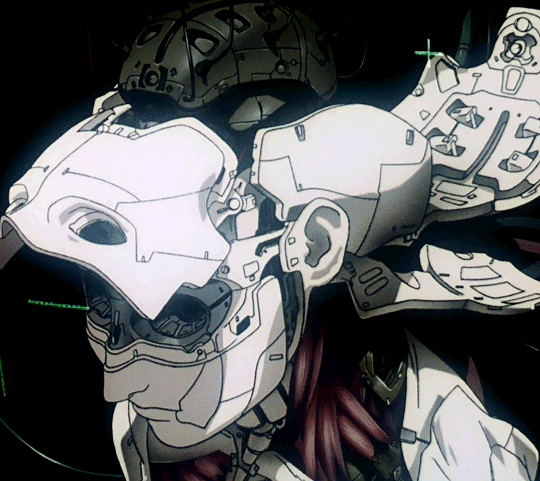
(Originally this was just going to be an excuse to talk about Ghost in the Shell... but I gotta be thorough.)
This was all brought on from this picture from a 1989 fanart magazine...
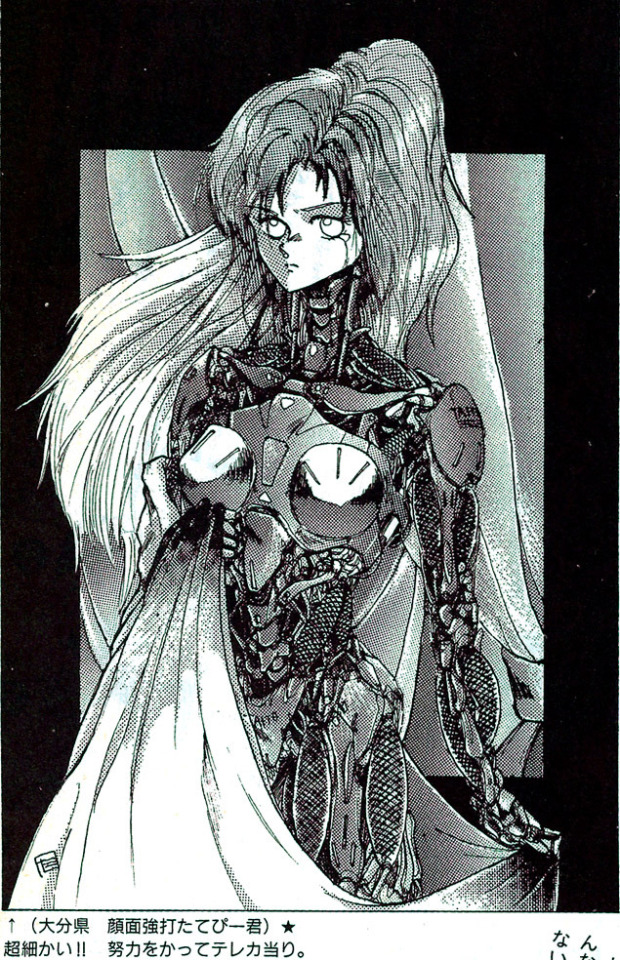
by an artist going by ‘Facepunch Tatebi-kun’ (顔面強打たてびー君, Ganmenkyouda Tatebii-kun). I remarked that it was interesting to see these kinds of ‘robot muscles’ in a picture from 1989, since I thought that kind of design became popular in the 2000s.
On some reflection, I think I gotta revise that opinion! I think ‘robot muscles’ became a thing around the mid 90s in anime; in the West I think it took a bit longer. But you can also see precursors already before that.
So. One thing artists are super into is biomimetic robots. That is, robots whose form (and perhaps function) is similar to animals, especially humans. The word ‘android’ referring to a human-like automaton dates all the way back to the late 19th century, but the modern ‘android, robot, cyborg’ taxonomy apparently became established around the 40s.
There’s two types of humanoid robot that get a lot of play, especially in anime. One is the convincingly humanlike cyborg, which is the same size and shape as a normal human; the other is a what we call in English a ‘mech’, i.e. a big robot you can sit inside.
Of course, if your androids just act like humans all the time, then there’s not much point having them be robots. To really create the frisson of contrast between human and mechanical forms you have to show the mechanism somehow. This could be because the machine isn’t perfectly human-like, and has visibly mechanical joints - take a look at the works of @sukabu89 for very inventive depiction of this theme - or, the android could be damaged or undergo maintenance.
When you attempt to translate biological forms into a more mechanical design language, the traditional way has been to use hard, rigid shapes, since these make the contrast especially clear. In more recent designs, particularly as we started to see real robots with ‘artificial muscles’ such as the ones created by Boston Dynamics, we get another sort of design language to express ‘mechanical parts’, and robots start having more biological forms with exposed plasticy muscles.
So let’s tell the story. We begin at the end of the 70s.
the dawn of mechaguro
For an early example of ‘mechaguro’ (a term I’m applying very anachronistically!), when a robot gets smashed up, we have Alien (1979). This film did a ridiculous amount to define sci-fi design language, and of course the alien itself blends mechanical and biological forms, with its glossy black surface allowing it to seem to melt into the exposed pipes of the spaceship. But let’s focus on the character Ash, a secret android who is broken apart in the second half of the film.
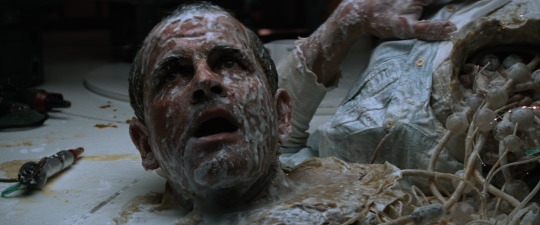
When Ash is torn apart by the alien, his insides consist of weird white plastic beads and a milky fluid that seems analogous to blood. It’s not clear what the function of any of this tech is - it’s intended to be vague and mysterious. The outside is biomimetic but the inside is anything but. He has a kind of artificial skin which resembles a latex mask.
The Terminator films are another major touchpoint for 80s science fiction. Late in the film, Arnie starts taking damage which reveals the Terminator skeleton underneath his fake skin.
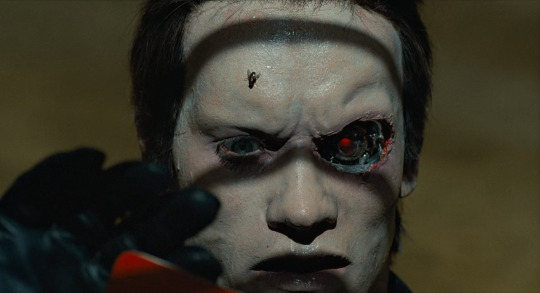
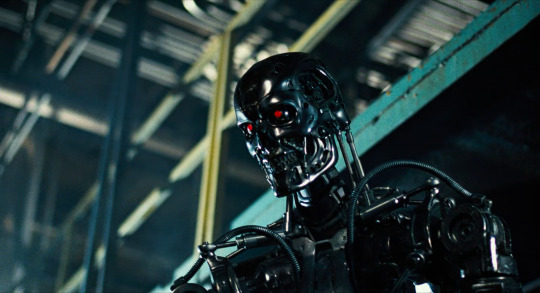
The stop-motion Terminator model is basically designed according to the principle of ‘replace human bones and muscles with hard metal bits’. So you have a metal skull, metal clavicles (which are pistons for some reason), metal shoulder blades, hydraulic pistons generally in the places where muscles are. e.g. in the above picture you can see pistons that stand in place of the sternocleidomastoid muscle, and in this picture...
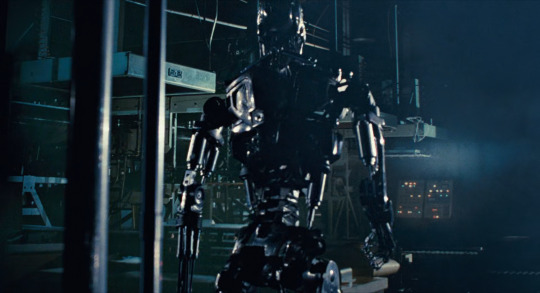
...you can see metal scapulae and piston biceps and triceps and a piston. The shoulder joint by contrast built in a very non-human-like way. Also there’s random tubes everywhere lol.
That’s generally how androids are portrayed in the 80s. The ‘droids’ in Star Wars are similar; C-3PO is an arrangement of metal plates with gaps suggestive of underlying mechanical details and rudimentary joints and pistons.
In Blade Runner, we have the Replicants, humanoid robots - but by the premise of the film, they are essentially indistinguishable from humans. So when the Replicants die, we never really get to see their robo-innards.
and now, anime
OK, that’s the big four Western 80s sci-fi movie series; what of anime? Of course, androids in anime go all the way back to Astro Boy. But most of these early designs don’t really focus on mechanical details all that much. Super robot designs are more like tokusatsu suits than anything. There were certainly instances of impressive mechanical animation in the 70s, with early experts including Kazuhide Tomonaga on Space Battleship Yamato. Then there’s Hayao Miyazaki’s episodes of Lupin III Part 2 which featured proto-Nausicaa flying a prototype of the robots from Castle in the Sky. It would be some years before anyone could come close to matching these!
The original Gundam in ‘79 famously started the ‘real robot’ movement [Animation Night, so let’s take a brief look at how a Gundam fits together.
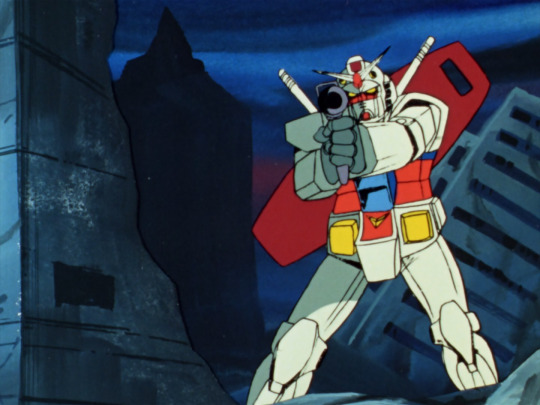
Generally speaking, the way Gundams are drawn in Gundam ‘79 is kind of rough. The methods to animate these rigid mechanical systems in super accurate perspective were just not yet established at the end of the 70s, certainly not on a TV budget. The actual joints on the Gundam are left very vague, but it broadly speaking seems to move like a human in armour.
But the OVA boom was about to begin, and while it would be a while before we saw the heights of Headgear/Production I.G./Gainax, things were going to change a lot. Mechanical design and animation was about to get much more sophisticated very very quickly.
In 1982, we have Super Dimension Fortress Macross, with robots that transformed into fighter jets. Its robots are designed by Kazutaka Miyatake, who cut his teeth doing mechanical design for Space Battleship Yamato and Daicon. The Macross TV series introduced the world to the animation of Ichirō ‘Missile Circus’ Itano. [AN64] A plane with legs... honestly looks kind of goofy, but Itano’s ambition to have a highly mobile 3D camera that could move in ways that would simply be impossible in live action marked a huge step up in how robots are animated. And this would get refined even further in the film Do You Remember Love.
In terms of design, we’re really moving our inspiration from ‘tokusatsu suit’ to ‘military hardware’ here. A Macross suit has to look like something that could transform into a plane, so its silly little arms and legs have to look kind of plane-like. In any case, we are definitely still in a world of hard and rigid robotics.
Dallos (1983-4) dir. Mamoru Oshii is known as the first OVA, if not the first successful OVA [AN115]. It features a variety of mining robots on the surface of the Moon, which are generally less humanoid, taking their design cues from JCBs...

...as well as humanoid robots with fairly clear joint patterns...

...and more humanoid robots too.
The eponymous Dallos, however, is a huge humanoid robot that looks like this...
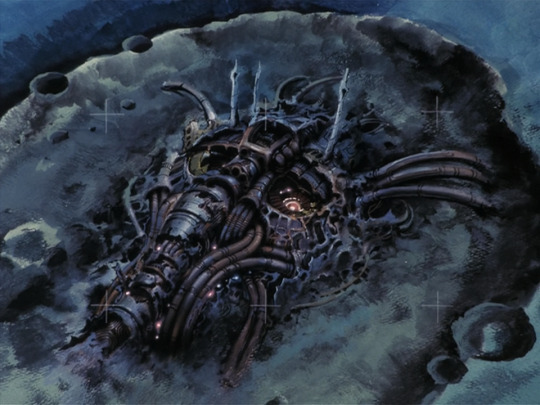
Here we have a pile of mechanical shapes that vaguely calls to mind a human face. It’s suggestive of motifs we’d see later in works like Akira.
A year later in 1985, Megazone 23 really kicks off the OVA boom in earnest [AN 103]. It also has a robot, in the form of a transforming bike that can become a humanoid piloted mech...
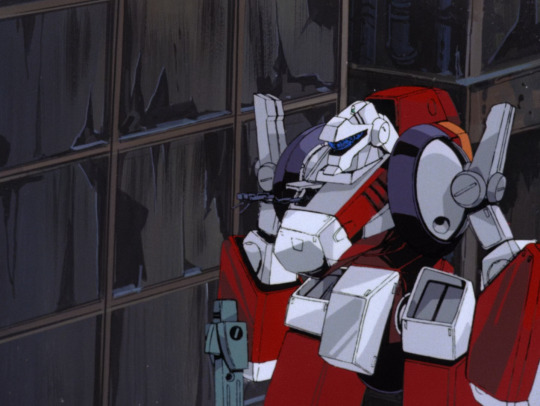
You can see mechanical designs and shading have become considerably more detailed; its motion is a lot more complex as well with a ton of indulgent background animation shots. The actual details of the bike -> robot transformation are rather brushed over. But to sort of sum up the design language: we have organic but hard-edged shapes contrasted by inorganic but round shapes. (These terms ‘organic’ and ‘inorganic’ refer mostly to symmetry and a sense of ‘flow’ in the shape.) There are few right angles as such, but a lot of broadly boxy topology. The shapes are broken up by elaborate specular highlights in complex shapes, a motif of the later Kanada school.
OK, but that’s all variants on ‘rigid robot’ so far - what about the androids? What about the more directly biological designs?
Following the enormous success of Megazone 23 Part I, Toshiki Hirano got the chance to adapt his favourite lesbian cosmic horror hentai manga Fight! Iczer One into a rather more tame OVA which released from 1985-87. In terms of mechanical design, this starts to do some interesting moves towards blending biological and mechanical forms...
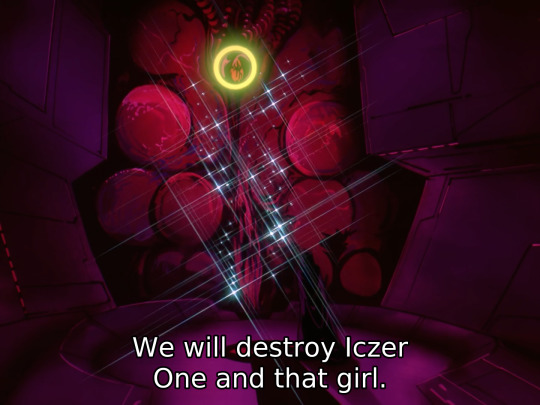
Of course it has a robot in addition to the requisite bishōjo and lightsabers. In contrast to the boxy shapes we’ve seen so far, the robots in Iczer-One have a much more curvy organic sort of design language. Still, there is not a lot of emphasis on the precise details of mechanical articulation outside of select shots. (It is however notable for the first ever Obari punch!)
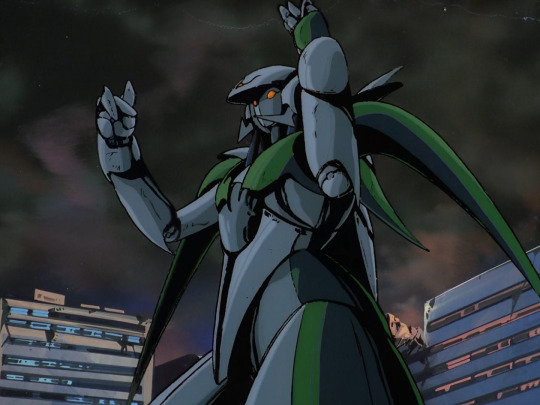
Despite the change in shape language, these are still very clearly animated as metal plates and not yet muscles.
In 1984 we have a very important film (for this narrative, and in general), Nausicaa of the Valley of the Wind, the film that created Studio Ghibli. Here we have the ‘God Warriors’, giant humanoid weapons with the ability to shoot a massive laser out of their mouth. Rather than robots, these are very much biological in nature, having to be grown in a kind of cocoon. In the film version of Nausicaa, an incomplete God Warrior is released, leading to an iconic scene animated by Hideaki Anno in which the God Warrior attempts to blow up the oncoming wave of Ohmu.

The God Warrior’s melting flesh is gorgeously animated, bubbling and sloughing off in great big lumps as the skeleton pokes out from underneath. Throughout, Nausicaa is full of beautiful and impressive animation of both machines (mainly planes) and biological (the giant insects), but the God Warriors, as human-made lifeforms, bring the two together. However, this strand wouldn’t be especially followed up on for a long long time.
Right, but what about Bubblebum Crisis (1987-91)? That is, after all, the iconic 80s robot girl OVA. It’s inspired heavily by Western robot-related films like Terminator and Blade Runner; here we have ‘Boomers’ (never stops being funny) as androids that can appear convincingly human. Like the Terminator, the underlying metal parts can burst out. Here we have a metal frame designed to resemble muscles, and also metal tentacles.
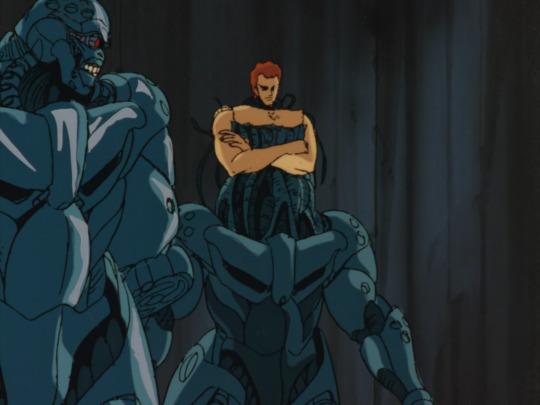
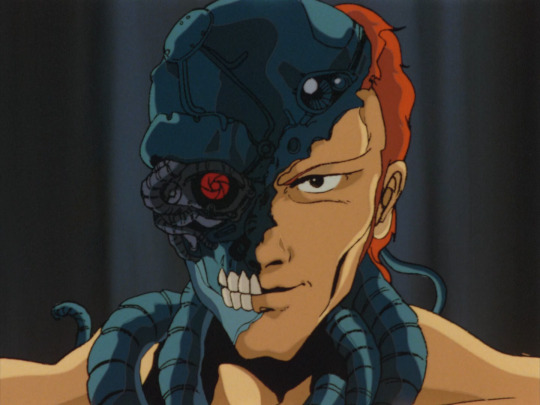
The shapes of these robots are a lot more organic. The robot neck has tubes that sort of resemble the neck muscles, metal plates that resemble pectorals and abs and deltoids and biceps and so on. You’ve even got a direct riff on the Terminator ‘fleshy face falling away to reveal metal skull with glowing red eye’! Under the plates there are clusters of tubes which also heavily resemble muscles. Also you’ve got the classic ‘three small circles’ motif there.
Contrasted against them are the Knight Sabers, who aren’t cyborgs as such but fight in powered exoskeletons which fit the design motifs of robot girls.
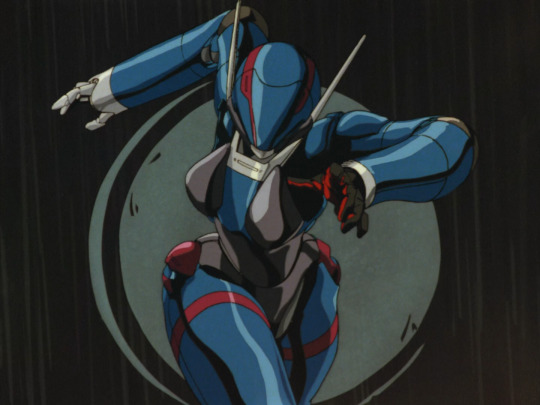
These suits are quite form-fitting, with a rubber under-layer and metal shells on top. There is definitely some attention paid to how they’ll articulate around the joints. One very recognisable 80s motif is the sort of extending spike thingies you can see on her hat there; there’s also the jets that extend out behind the suit. And, you have that multi-layer shiny highlighting of course!
Still, the way the characters move in Bubblegum Crisis is still very squarely Kanada School poses; big movements, lots of held poses accentuated by flashing and line boil, not a lot of concern for conservation of momentum or anything like that.
For a contrasting strand we can look at the rise of the ‘Otomo school’ (if you will) of realism. Around the end of the 80s, a pool of talented animators were gathering around Katsuhiro Otomo. Their most famous work is Akira, but I’m actually going to begin with Robot Carnival (1987), a wonderful anthology of short films from 1987. This features a huge variety of interpretations of the concept of robots.
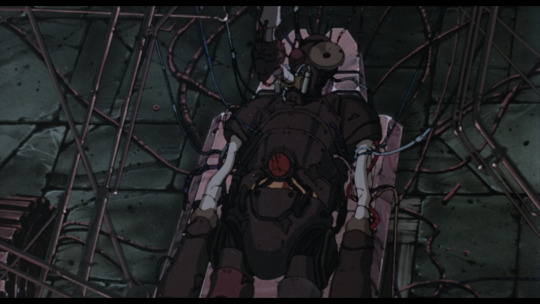
For example, for Kōji Morimoto, later co-founder of Studio 4°C, the robot is a kind of cobbled-together steampunk Frankenstein’s monster. It’s a very cool design with all sorts of asymmetries and exposed parts suggesting its cobbled-together nature. And although all the robot does in this short is stand up and then fall over, a great deal of attention is paid to the little details of its articulation and its movement through space.
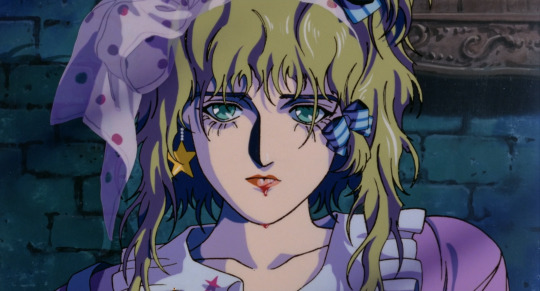
Presence, directed by Yasuomi Umetsu, is notable for its steps in the direction of realism - Umetsu’s characters are hyperdetailed and in some ways over-drawn. The opening shots establish this is a world where lifelike androids are common, when an android gets his head kicked off and stolen by children. Here the robot-as-doll metaphor comes in, something that will be increasingly central in the next decade. The robot girl is essentially a human-sized doll in a room full of other toys. Her creator smashes her to pieces with a wrench; later her ghost visits him as an old man. We see the girl attached to a bunch of wires, but she bleeds like a human.
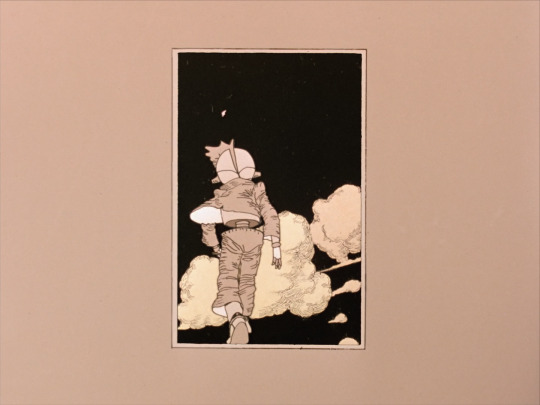
Cloud by Manabu Ōhashi features another humanoid robot, an Astro Boy-like child recognisable as a robot based on his segmented torso and legs and robotic ear... cones. Here the robot is a standin for human emotions, the boy’s struggles projected onto the constantly changing sky as he walks against the wind.
Strange Tales of Meiji Machine Culture: Westerner’s Invasion by Hiroyuki Kitakubo (later to direct Golden Boy, Roujin Z and Blood: The Last Vampire) is a sendup of mecha shows in which two very goofy looking steampunk robots operated respectively by Japanese and Western crews duke it out, laying waste to the city around them. The Japanese robot is basically a big wooden samurai...
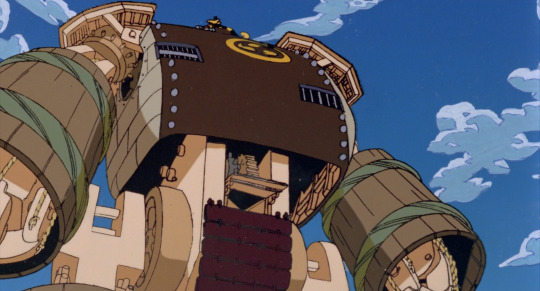
and the Western (more specifically American) robot is, uh
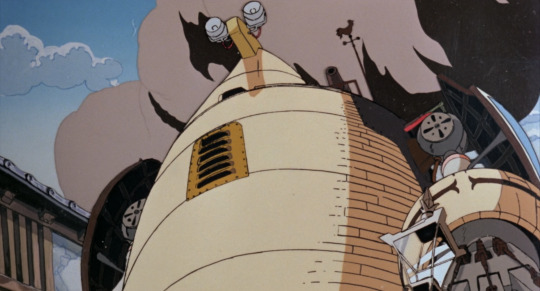
sorta big barrel with little eyes on top? I’m not entirely sure what the deal is with this design!
That’s really not relevant to our story tbh I just think it’s a neat short.
Chicken Man and Red Neck, by Takashi Nakamura, features especially distinctive robot designs. The film is kind of a dream sequence in which a terrified drunk man witnesses the revels of the machines of Tokyo, transformed into robots; the robots are extremely shaped, moving through a world that is pretty much just pistons...
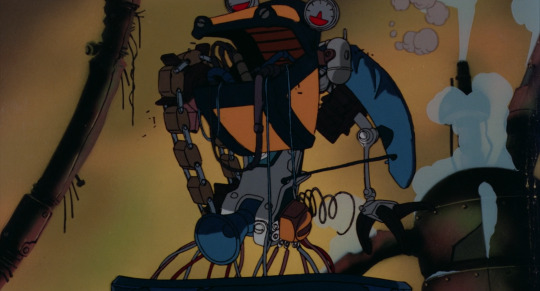
These robots call to mind the dancing demons in Fantasia’s Night On Bald Mountain sequence, or even Bosch.
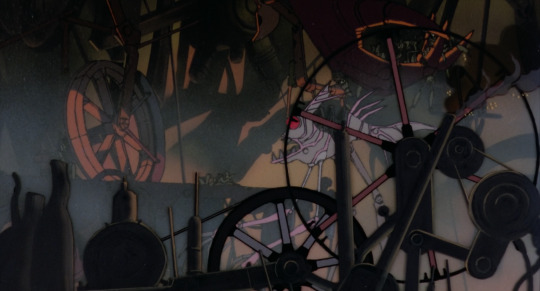
Otomo’s own segments feature the Robot Carnival itself, a vast mechanical structure built as... well some kind of entertaining spectacle, but which now drives around the post-apocalyptic wasteland dropping robots which explode as bombs. It’s cute.
OK, to wrap up the 80s, we gotta cover Akira (1988) [AN34]! Akira has plenty of impressive mechanical animation of helicopters, hovercraft thingies, satellite lasers and of course the famous bike, but it doesn’t really feature robots as such - but what it does have is a blending of mechanical and biological forms in its climactic sequence where Tetsuo’s psychic powers go out of control. First, wires start to spread like the roots of a plant from his robot arm - less an actual machine and more something he assembled with his psychic powers...
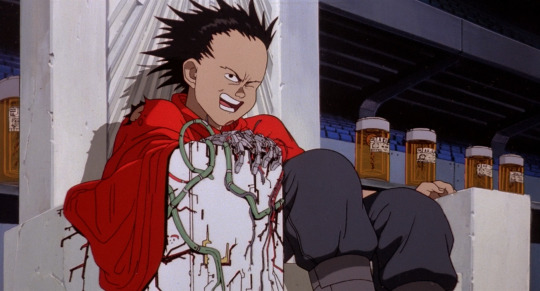
He takes a bullet, and the mechanical wires and muscles start to blend together and spread out like a slime mold...
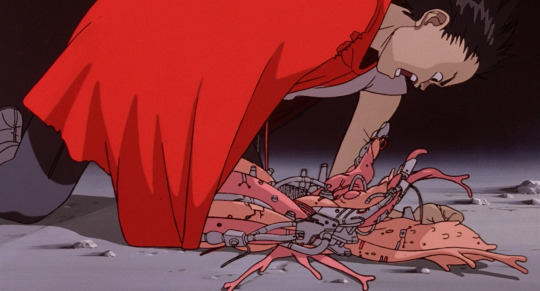
...which he can extend as essentially a giant tentacle.
When his powers fully go off the rails, he bulges out into big blobs of flesh which have both veins and wires running over them. These burst out of the metallic parts as well.
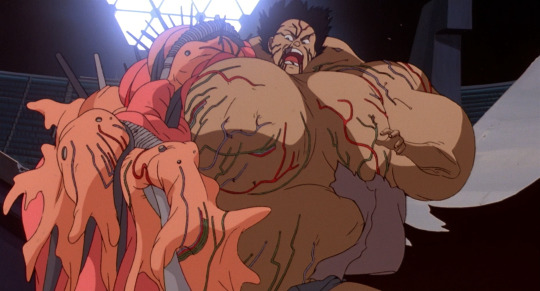
He turns into essentially a giant biomechanical baby.
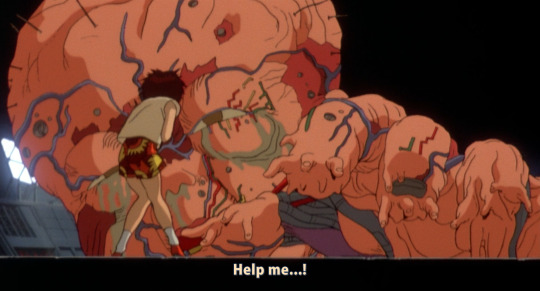
Did Akira invent these images of blending biology and machinery? Probably not, but I’m not really familiar enough with manga of the time to say. What can at least be said is that Otomo’s absurdly meticulous style could really sell it. Otomo was truly a god of perspective and detail; Akira the film was an enormous, prestigious production that threw ludicrous effort and resources towards realising his vision (which doesn’t mean it paid its inbetweeners much more...). A lot of the animators who worked on Akira would go on to be prominent in...
the 1990s
So, the 1990s. If the 80s was dominated by the later Kanada School, the new movement of the 90s, at least as far as film animation goes, was ‘realism’.
But before we get onto that, let’s take a brief look at Gunnm (1990). Known as Battle Angel Alita in the West, this manga by Yukito Kishiro depicts a world in which most people are cyborgs; it was adapted to an OVA by Madhouse in 1993 and became wildly popular overseas. Its protagonist Gally, aka Alita, starts out the story as a wrecked cyborg body like this...
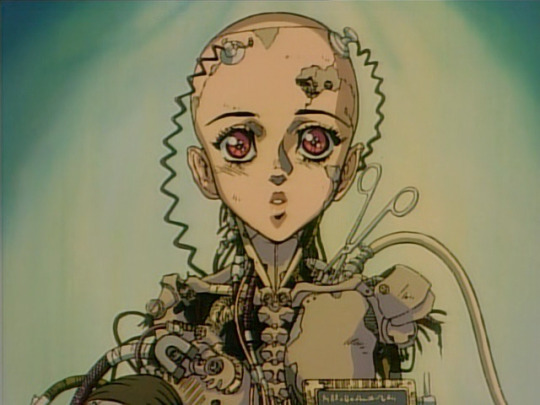
Looking at this design, you can see similar patterns as we have so far. We have metal clavicles, metal sternocleidomastoid muscle, metal pectorals, metal spine. There aren’t robot muscles, per se, but there’s a lot of attention to detail on mimicking biological shapes.
Before long she is rebuilt (twice in the manga, once in the anime). Her new body is like this...
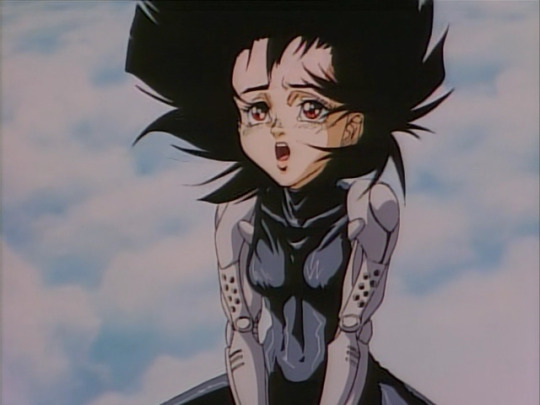
...which is to say a skintight bodysuit in the middle, and metal arms. These arms, although designed in a way that indicates hard surface and with a hinge joint at the elbow, are designed in a way that mimics the flow of muscles in a human arm. By contrast, her sorta-love interest Yugo has a body like this:
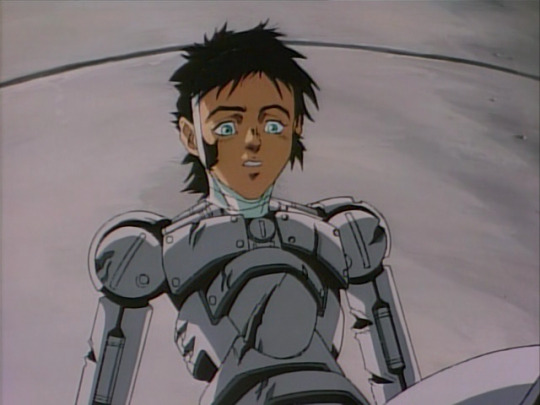
which gets mashed to pieces in the finale of the OVA. There’s a striking mechaguro scene in which Gally catches Yugo, but leaves him hanging by a fraying arm, which snaps, leaving him to fall to his death. Compared to later iterations of the ‘robot arm torn apart’ device, this one’s relatively light on detail...
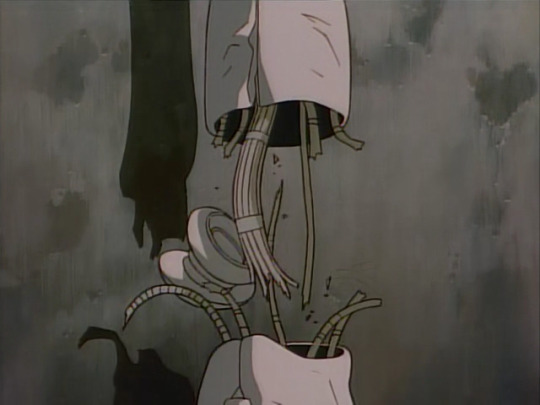
Cyborg bodies in Gunnm are used as a visual indication of character type. Gally has curves but also sleek robo muscles: she’s a Beautiful Fighting Girl, sweet but also extremely powerful. A huge ‘muscular’ cyborg with wide shoulders is likely to be a brute. Yugo here has much more plain, simple shapes with visible bolts, not precision pieces like Gally.
I don’t know how much of this originates with Gunnm. I’m sure the idea of cyborg girls was in the air long before, but this became an influential example on the tail end of the time of the 80s bishōjo. One device that is notable here is the idea of a ‘full body cyborg’, which is only human down to the brain (or perhaps not even that). Body swapping is a major theme in Gunnm, something that would be expanded on before long...
And if that was going out, what was coming in? Let’s look at Patlabor, which traces the evolution of the Headgear artistic collective and IG Tatsunoko into Production I.G.. This is about as down to earth as giant robot stories can get, with robots as just everyday machines used for work and by the cops. But where things really go nuts in animation terms is the opening to Patlabor 2 (1993).
youtube
Here you can see some of the most impressive sequences of mechanical animation ever drawn. We see pilot Noa testing out the robot, and especially notable are the scenes of the hand flexing and of walking. Enormous attention is paid to the articulation of joints. The robot’s hand can swivel 360 degrees, unlike a human; however, like a human, the articulation of the fingers seems to be controlled by hydraulics in the forearm (whereas in humans, the muscles and tendons in the forearm control our fingers). When the robot’s foot steps, it flexes like a real human foot, with believable joints, and a sensible arrangement of pistons to absorb force.
It’s not imitating a human’s muscles, but the attention to the details of the robot’s mechanical design serves precisely to draw our attention to the ways it’s like/unlike a human - the robot’s hand impossible motion immediately contrasted with its pilot shot from the same angle. And the perspective drawing is absolutely impeccable. The robot is made of purely rigid structures, and the way rigid structures articulate is not at all how a human’s joints articulate.
The sequence above was animated by Atsushi Takeuchi. But across the board, the bar was getting pushed for mechanical animation. For example, observe this cut from Mobile Suit Gundam: The 08th MS Team (1996-1999), in which the robot tears off its own arm and beats up another robot. The precision of the way the joints are animated and the way the robots move in space is just completely on another level compared to what Gundam had been doing a couple of decades prior.
Anyway, we’re here to talk about robot muscles, and we’re just a few years out from that now!
The year that robots got muscles, at least as far as anime is concerned, is 1995.
You can probably guess the next part. In 1995, we get Eva and GitS. Let’s start with GitS, to continue the Production I.G./Mamoru Oshii thread. The opening sequence of GitS, animated by - who else could it be? - Hiroyuki Okiura - has to be one of the most iconic segments of video ever drawn. Here’s a merely 720p youtube upload but go and find the place you have GitS stored on your hard drive and watch it in proper quality eh.
youtube
OK, yes, a lot of it is a naked lady floating around, sue me or whatever. But the sense of form. We see early on an appearance of ‘robot muscles’, here closely resembling real muscles...
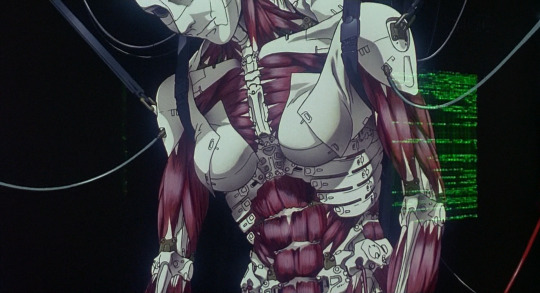
We can see from the way this is drawn that it’s made of a combination of artificial muscles, solid segments, and flexible, fabric-like panels. One of my favourite shots at the beginning shows the solid segments of the skull clicking into place. Here we have a very clear contrast between the angular, hard edges of the mechanical pieces against the organic forms of a human body.
Elsewhere in the film, we see various incredibly cool bits of ‘wouldn’t be fucked up if a body did this‘, like the fingers...
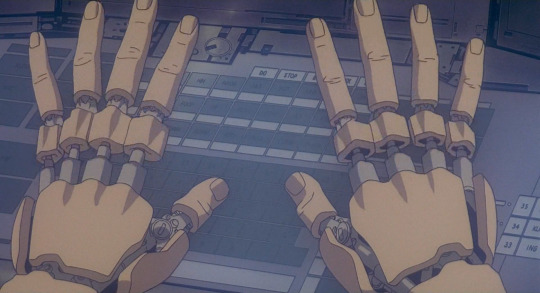
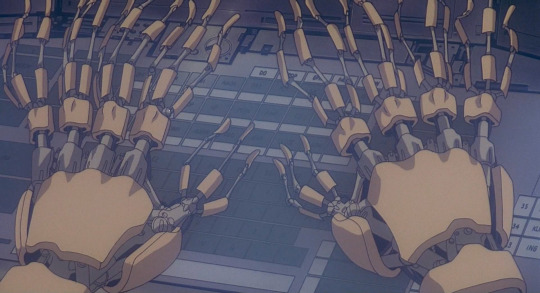
Here, what we expect to be soft biological fingers is contrasted with unexpected rigidity, mechanical joints under a shell.
Also in this scene we encounter a robot body that has been stripped of her arms, legs and hips but is nevertheless still alive...
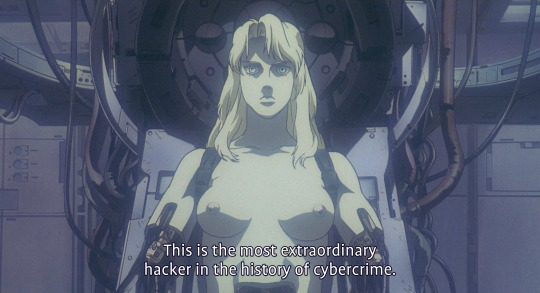

most extraordinary hacker in the history of cybercrime and you have your titties out and yet you still can’t get them to stop misgendering you, smh
For the Terminator, having its body smashed up and continuing to walk was a demonstration of its strength. Here, as would become perhaps an increasing motif, having a robot body is a source of vulnerability: people can do things to you that would kill an ordinary human but you keep going through it. Not surprisingly, ‘robot body maintenance’ is a recurring porn device. (One that GitS deploys in SAC s2).
But of course this all builds up to the all time classics of mechaguro scene at the ending where the Major attempts to tear off the hatch of a spider tank. Muscles ripple individually under the surface of her skin, her arms bulge in exaggerated contraction, and then her arms fully tear apart under the force.
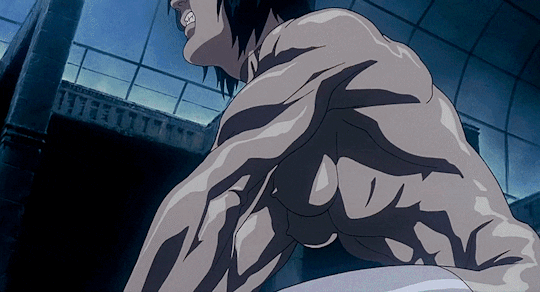
Here, we’re showing her as mechanical not by contrasting rigid forms with biological ones, but by exaggerating the biological ones to the point of doing something extremely unnatural. Human muscles do not generally flex in such an individual way, nor are they strong enough to tear the arm apart, but robot muscles? Yeah, they could do that. This sets up the next scene where the Major lies unnaturally still, but can still exert control through hacking through her union with the Puppet Master.
Robots holding onto something so hard their arms explode has become... if not a recurring image, then at least one that was called back decades later in Violet Evergarden.
The final scene of GitS brings back the image of robot-as-doll, with the Major’s consciousness now uploaded into a black-market robot body that resembles a child in a dress.
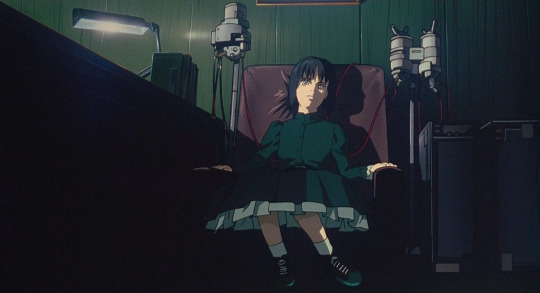
This is further expounded on in Oshii’s second GitS movie Innocence (2004), with its Ballade of the Puppets in the soundtrack as Batou and Togusa (and eventually, the Major) are attacked by essentially an army of ball-jointed doll gynoids. The puppets’ movements are extremely unnatural and erratic acrobatics, constantly flipping all over the place; when hit by bullets, panels pop open to reveal the underlying brass skeleton. It’s a very cool image. (The thing that lets the sequence down is the extremely dated CGI and aggressive digital compositing.)
It also has Donna Harraway as a literal cyborg!
Now, the GitS movies didn’t drop fully formed out of nowhere, but draw on the work of Masamune Shirow. The manga has a somewhat different design sensibility than the movie, distinctive and shiny as all Shirow’s art. It is more rounded and organic, less cold.
So, the basic design of a cyberbody originates with Shirow. You can see it on this page (unfortunately from a flipped version, translation Dark Horse):
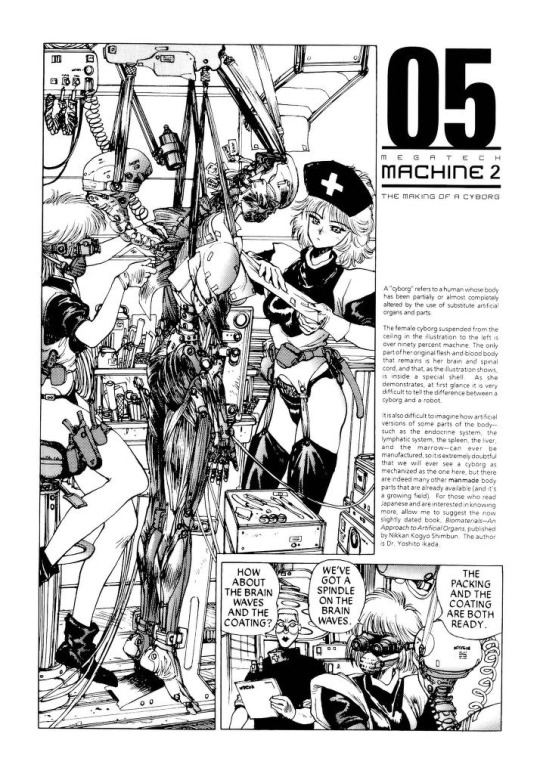
You might be able to determine from how the nurses are dressed that, yeah, the GitS manga is in significant part fetish porn. But really nerdy fetish porn, which is the best kind. This chapter is almost entirely dedicated to explaining how cyborg bodies are constructed in great detail, from the ‘sensory film’ (that’s what’s being applied in the opening to the 1995 film) to the hair implantation.
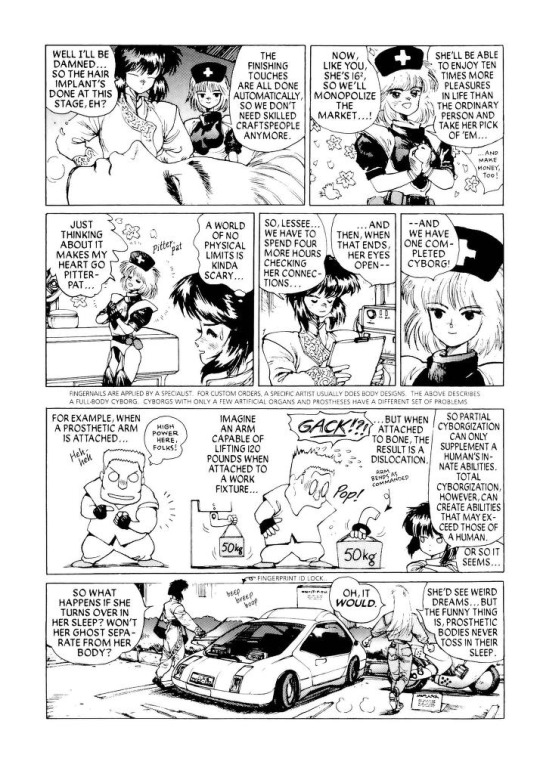
It’s interesting seeing how some of the more out-there designs of the manga, like Chief Aramaki, are transformed into the realist style of Hiroyuki Okiura. It’s Okiura, so it works great of course.
I don’t know if there are manga examples of such detail about cyborg bodies that predate Shirow.
Anyway, that’s just one of the two punches dropped in 1995. The other is Neon Genesis Evangelion. To the pedants: sure, the Evas are not actually robots, but they’re giant cyborgs that play the role of ‘robot’ in the story and they look like robots so I’m counting them.
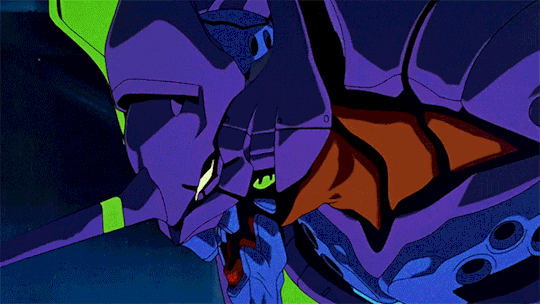
Anyway, the thing about the Evas is they are incredibly lithe. They run, rip and tear and swing heavy objects around in a way that’s both weighty and distinctly biological. Their bodies are extremely flexible compared to prior mechs (look at how much the spines bend in that Iso cut from EoE!), but not without hard, rigid components such as the shoulder towers. Their jaws are bestial but feature mechanical-like components like interlocking hexagonal teeth and jet-like vents. They are in short a fantastic design that blends biological and mechanical features.
The impact of Eva on just about everything can’t be overstated, but as far as robot design, well. There certainly were works that leaned on the precedent set by Eva, as for example RahXephon, which also treats robots as something spiritual, prone to popping into a blob of weird little bubbles just like in Eva.
There’s a great deal missing from this account. I am very focused on anime because I’ve watched a lot more anime than I’ve read manga or played games from this period. So I’m sure there’s major foundational works I’m missing here!
the 2000s
When did the West start to catch up? eh that’s subjective - David Cronenberg was way ahead of the game! - but specifically in the sense of robots with mechanical muscles, I think the major points in the timeline go a bit like this.
In 1999, there’s the Matrix, which leans heavily on anime. This features a similar ‘robot takeover’ premise to Terminator, but here it’s biomimetic robots modelled after squids, with clouds of constantly moving tentacles that sweep behind them. After making a cool half a billion dollars, the Wachowskis decided to pay all their favourite anime directors to make short films. I’m not going to comment on every part of the Animatrix, since most of it isn’t really relevant, but I will point to this horrifying cut by Takeshi Honda in The Second Renaissance in which a robot woman has her clothes torn and then skin bashed off by a mob. The framing, motion, her expression of abject terror, and the ‘reveal’ of her ‘true’ nature, all viscerally call to mind a trans bashing.
On the manga side, a big one to mention is Gantz, a gory nihilistic seinen manga which ran from 2000-2013. The characters in Gantz fight in special latex-like suits which take on the appearance of muscles while engaging superstrength, but can also sustain damage that causes them to drip fluids from ports located at the neck and become fatal to their wearer. Gantz was adapted to anime by Ichirō Itano in 2004, but I haven’t seen it so I can’t comment on any notable animation.
Cyborgs are a favourite subject of games, but in the 2000s, games are really pushing art direction and biopunk stuff is in. Half Life 2 (2004) has its spider-crab like Striders and dropships and so on. Oddworld: Abe’s Oddysee (1997) bases its whole concept around the sheer variety of weird creatures that would inhabit its dystopian factory. And I gotta give a shoutout to Septerra Core (1999) - in case one other person has played that lmao
At some point after 2005, Boston Dynamics became a viral sensation thanks to their robot BigDog. BigDog is just welded steel and hydraulics, but its lifelike hopping movement style definitely brought to mind the idea that the future of robots is going to be in biomimesis.
So, 2007, here comes Crysis to melt your PC! This is an FPS with the not-uncommon premise of being a supersoldier fighting (country America hates) and also aliens, but its gimmick was that you have a special exosuit that wraps around your body with artificial muscles, making you much stronger and manlier or whatever.
youtube
This is indicated by a visualisation that could be right out of a toothpaste ad, where tiny little balls drop into the character’s pores and somehow go straight into the bloodstream which is of course a void full of flying red blood cells. And so on. It sold the game, though! The ad there focuses almost entirely on the suit and not the character wearing it, who is basically an irrelevant soldier man. What it entailed in gameplay terms is that you have a mode switcher so you can have strength or armour or invisibility or whatever. But it’s cool military superscience, you see!
Anyway. Not like my preferred flavour of cyborg is any less stupid I guess x3
In the same year, Bayformers started. These films’ robots are honestly just visual noise, there’s so many moving metal shards going every which way that it’s next to impossible to discern any sort of underlying mechanical principle. A similar ‘overwhelming business’ visual effect would be applied the next year in Iron Man, kicking off the MCU. So mechanical muscles definitely weren’t the only expression of ‘hyper-advanced robot’ in Western visual media in the late 2000s.
I’m going to end my story with two more games: Horizon Zero Dawn and NieR Automata.
Horizon features a world inhabited by a large variety of robot animals, using the peak of AAA rendering techniques. The robots are designed to be biomimetic after both modern animals and prehistoric ones, and feature a combination of hard surfaces and softer biological muscles. For example, a robot horse:
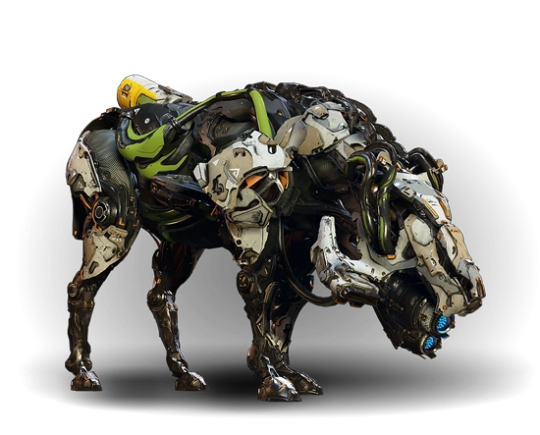
The discipline of making designs like these now has a name: it’s called ‘hard surface modelling’ and it involves boolean operations and bevels and other techniques designed to create a balance of hard edges on a surface against the smoother parts. The design language of Horizon says that the hard plates are white, the soft parts are very dark and may be patterned like a cloth texture, and there can be small colour accents here and there.
I think you can definitely see the influence of Boston Dynamics’s robots (and recent military tech in general) in these designs, iterated on through a decade and a half of increasingly intra-referential concept art. They are visually very busy designs, but there are a couple of recognisable features that draw attention by being inorganic, such as the cylindrical fuel tank at the back. Vitally, the silhouette is very readable.
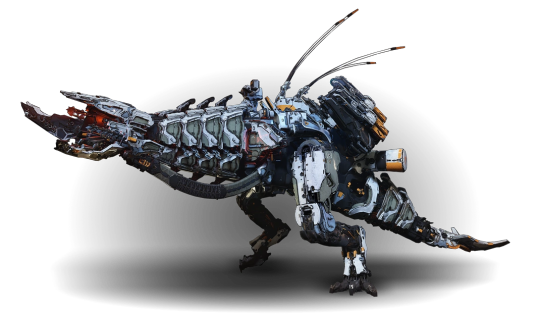
This robot T. rex for comparison serves as a world boss monster, and you can see it’s got a bunch of military looking attachments that look like radars and missile launchers and so on. As real tech evolved, so too did our idea of what a scary robot ought to look like.
So, that’s where this kind of design pattern has gone in mainstream games.
Now to finish, a brief comment on NieR Automata. Its designs draw hard on those of Ghost in the Shell. Visually it draws a strong contrast between the Machine Lifeforms, who have inorganic shapes (spheres and cylinders) and very visible and plausible mechanical joints, and the doll-like androids, who might as well be human (although A2 provides some contrast in an android who is damaged enough for the underlying materials to show through). The mechanical nature of the androids is communicated by the acrobatic way they move and the interface elements, and dead androids you find in the field - and later when they start losing arms and stuff, it’s a whole thing. But just like humans in Yoko Taro Games, they’re capable of dying in a puddle of blood.
(I guess if you take one thing from this post it’s that if you’re a robot, don’t expect to keep your arms.)
Robot muscles gives you a chance to give both the ‘anatomy porn’ of drawing something very precisely right, with the added bonus of giving you a reason to draw the muscles écorché, and the chance to make it weird and defamiliarised by splitting it with mechanical elements. In short... they look cool!
In this whole post I’ve basically not touched at all on illustration. I can point to a variety of illustrations of robot girls, but in terms of periodising them, I just don’t think I know enough. Though it’s safe to say that cyborg bodies in various states of construction or disrepair are now a mainstream of concept art - and that Ghost in the Shell is usually cited as an influence. I don’t know if robot muscles ever truly became the mainstream way to depict a robot, but it does feel like they’re increasingly common.
One artist I will briefly mention (besides sukabu), mostly bc I think they’re neat, is Haruyo Megurimu, who draws these very intricate designs of ‘necrotech’ which is sort of very biological robots extending out of human bodies - limbs extended on long spindly insectoid strands, jaws splitting open, that kinda thing. Can’t say who influenced them or anything but it’s a compelling extension of the idea into a particular corner of aesthetic space.
And that’s all I’ve got I think. There’s definitely big gaps like. More recent sci-movies. Western comics. Nevertheless, that’s an arc.
If you’ve read this far: thank you for indulging my autism.
810 notes
·
View notes
Text
Just wait until this guy finds out about pseudosuchians!
Birds are Dinosaurs
Dinosaurs are not Lizards
None of this is a matter of opinion or debate
Get over it
Love
A Paleontologist
#for anyone not into taxonomy- pseudosuchians (aka 'fake croc') are the clade that crocodilians are a part of#and i think its bc the naming happened before we knew? but its funny as hell bc taxonomy refuses to change names#like ever. they hate changing names unless they HAVE to
4K notes
·
View notes
Text
the "chat is a pronoun" discourse is captivating to me because it goes so far beyond ordinary misinformation
like imagine if suddenly there was a wave of posts saying that Dogs Are Birds, like "omg you guys i just realized dogs are actually birds!!!" and any time anybody said "theyre mammals, not birds" dozens of people would get super defensive about it and make snide condescending posts/comments like "KNOWLEDGE is knowing that dogs arent birds, WISDOM is knowing that taxonomy is fake and all organisms are whatever you want them to be forever, peace and love on planet earth," and they would keep posting about how Dogs Are Totally Birds because "well dogs are majestic and have beautiful voices, like birds" and if you pointed out that those qualities are immeasurable (& have nothing to do with being a bird) and that metric could categorize most animals (& several things that arent animals) as 'birds' they would call you a gatekeeping elitist and say "let people enjoy things" or some thesaurused equivalent, and maybe someone would also say "we're just having a Laff, it's just a fun game dont be so Serious" but they (and a non-insignificant number of other people) otherwise speak as if they believe with conviction that Dogs Really Are Birds, and this is Really Big & Exciting News because Dogs Are The First 4-Legged Bird, and then when people who know biology made posts explaining in-depth what taxonomy is & why dogs arent birds theyd start getting asks like "what about cats, are cats birds??" "are hamsters birds?" "what about sharks??" "i think flies are birds because they have wings." and then imagine this all persisted for more than half a year
66 notes
·
View notes
Note
Hi!! Do you maybe know of any fics that feature touch-starved Sherlock? Thank you so much in advance, and I hope you have an amazing day!
Hey Nonny!!
AHHH I DO, BUT it's in a combined list if that's okay???
And you're in luck, I'm short on a list this week, so I'm gonna also post you the second short list I have as well!! I hope you enjoy, even if it's not EXACTLY what you're looking for!!
As always friends, if you have something, please add them below!
TOUCHING / TOUCH STARVATION Pt 2
See also: Touching / Touch Starvation
Bond, Sherlock Bond! by macgyvershe (T, 631 w., 1 Ch. || Fluff, Kissing, Couch Cuddles, Sexy Talk with No Explicit Sex, Bond Night, Established Relationship) – John is doing a Bond-a-thon. Sherlock is ready for a night of movies and munchies. Washed down with Devil Mountain coffee. Eventually everything comes together in the best of ways.
The Skin Over My Heart by standbygo (E, 8,849 w., 1 Ch. || Post-Hiatus, Fake Relationship, Case Fic, Dog Tags, Military, Homophobia, Gay Bashing, POV First Person Sherlock, Friends to Lovers, First Kiss / Time, Declarations of Love, Undercover, Haircuts, Flashbacks, Touching, Pining Sherlock, Hospitalization, Metaphors, Introspection, Hand Jobs, On the Couch, John’s Past, Angst with Happy Ending) – Sherlock and John are still trying to adjust to Sherlock's return from his hiatus when John's friend Bill Murray brings them a case. Someone is targeting the LGBTQA+ members of Bill's unit. John and Sherlock go undercover at the unit, but when they end up having to flirt to flush out the suspect, Sherlock realizes he's in over his head.
A Comprehensive Taxonomy of Tobacco-Ash by Silvergirl (E, 11,475 w., 2 Ch. || No TRF AU || Cranky Sherlock, Alternating POV’s, Self-Esteem Issues, Jealous John, Pining John, Confessions, First Kiss, Frottage, Bed Sharing, Sensuality, Cuddling, Touching) – A handsome academic approaches Sherlock about publishing his magnum opus on tobacco-ash in a prestigious scientific journal. Sherlock is quite flattered and flustered, and John’s nose is out of joint.In this little AU there is no Fall and no Mary. Instead, there is humor and smut. Truly a disproportionate amount of smut.
Spare Parts by Raina_at (E, 63,497 w., 10 Ch. || 24th Century / Futurism AU || Post TRF, Pre-TRF Relationship, Case Fic, Mutual Pining, Estrangement, Reconciliation, Science Fiction, Reunion, Nightmares, Angry John, Cybernetic John, Emotional Discussions / Heart to Heart, POV John, Scars, Past Drug Use, Forehead Touching, Emotional Lovemaking, Kissing, Apologies, Kidnapping, Rescue Mission, BAMF John, Bed Sharing, Top Sherlock) – Two years ago, Sherlock Holmes jumped off the roof of New London Hospital. Two months ago, he walked into John's clinic as if no time had passed at all. John hasn't seen him since. But then Sherlock knocks on John's door with a case he can't say no to, and while figuring out why the biggest manufacturer or synthetic limbs in the System is going after veterans, they also need to find out whether there's a way to fix what's broken between them. Part 1 of Realigning Gravity
Bakers with Benefits by Raina_at (E, 88,130 w., 14 Ch. || Great British Bake Off AU || Strangers to Lovers, Switchlock, Friends with Benefits, Mentions of Alcoholism / Past Drug Use, Banter, Flirting, Fluff, Light Angst, Semi-Public Sex, Past Sherlock/Victor, Mutual Pining, POV Sherlock, Obsessive Sherlock, John’s Bum) – Sherlock Holmes has a successful YouTube baking channel, but what he really wants is his own bakery. When an old friend sends him a call for the very first Great British Bake Off, he seizes the opportunity to finally win a sponsor for his bakery. Here's the plan: Win Bake Off, get the bakery, don't fall in love with the handsome Army doctor at the neighbouring station. Easy.
Fade To Black by twistedthicket1 (M, 93,389 w., 29 Ch. || Split Personality Disorder / DID, Action, Romance, Violence, Implied Rape/Non-Con, BAMF John, Fluff and Angst, Baskerville, Human Experimentation, PTSD, Implied Self Harm, Trauma Amnesia, Past Child Sexual Abuse, Protective Sherlock, Smoking, Meddling Mycroft, Past Victor/Sherlock, Gay Sherlock, Sherlock’s Past, First Kiss/Time) – John Watson believes one day he'll just fade. That he'll drown in the black spaces of his mind, and that one day he will no longer exist. It's always been like this, the dark spots marking out moments in his life he can't remember. Where for just a moment he's someone else. Having a Dissociative identity disorder, he can't even be entirely sure he's really who he says he is. Then he meets Sherlock Holmes. A brilliant detective who when he looks at you can read your entire life story. John is immediately fascinated and afraid, half-wondering if maybe Sherlock can see the other personalities in him and half terrified of the thought of him finding out. Becoming his flatmate seems at once to be a wonderful and horrible idea. Yet as John's Blackouts become more and more severe and his other personalities begin to truly awaken and show themselves with Sherlock's help, the two soon discover that sometimes even the kindest person can harbour a demon best left untouched inside of them. Because not all of John's other personalities play nicely and some may be hiding secrets best left undisturbed...
Drawn to Stars by Silvergirl (E, 109,272 w., 60 Ch. || S4 Compliant to TLD / TFP Doesn’t Exist, Sherlock’s Italian Adventure, Sherlock/OC and Johnlock, Jealous John, Mutual Pining, Misunderstandings, First Kiss/Time, Idiots in Love, 3 Part Story, Slow Burn, Inexperienced Sherlock, Bottom Sherlock, Introspection, Multiple Alternating First and Third Person POV, Separation and Reconciliation, Emotional Love Making, Love Confessions via Letters, Angst with Happy Ending) – After the Culverton Smith case Sherlock is clean, working, and looking for a romantic partner—since John has told him that’s what he needs. Shame John didn’t mention he was interested in that role himself, before Sherlock went off to Rome with a gorgeous Italian copper to try to fall in love and become a complete human being. Part 1 of the Drawn to Stars series
Sherlock Holmes Live by emilycare (E, 488,496 w., 73 Ch. || Theatre AU || Immersive Theatre, Romance, Slow Burn, Fake / Pretend Relationship, Fluff, Bisexual John, Demisexual Gay Sherlock, Alternating POV, Falling in Love, Eventual Case Fic, Soft Sherlock, Panic Attacks, Hurt/Comfort, Angst with Happy Ending, Pining John) – Down on his luck John Watson answers an advert for a paid role in an experimental play. Enter William Scott with a most unusual proposition: help him test run a two person immersive experience, oh and by the way there is sex and romance involved.
52 notes
·
View notes
Note
opinion on the absol being dog or cat debate
this was a debate? it looked more like people were trying to decide how someone elses phobia worked ( at least from what i saw? unless there were other posts)
well, i hate to break it to ya anon, but taxonomy is... a bit like gender. constructed by people who want to organize life into tiny ridged boxes, while being way too complex to truly do so
for example. a remoraid is less related to a luvdisk than it is to whimipod. and yet we call only the former two fish. by all taxonomical logic, reptile pokemon are birds. sharpedo are barely fish. this shit is FAKE. helpful for describing what a pokemon looks like and give you a general idea of what to expect when you care for one, but its all just guesswork and superstition in the end!!
absol are actually more closely related to the poocheyna line than to mabostiff OR persian, but, technically, it would be closer to persian on the "genetic tree"
18 notes
·
View notes
Text
If you donate to my gofundme we can make that 50000 even!

2K notes
·
View notes
Text
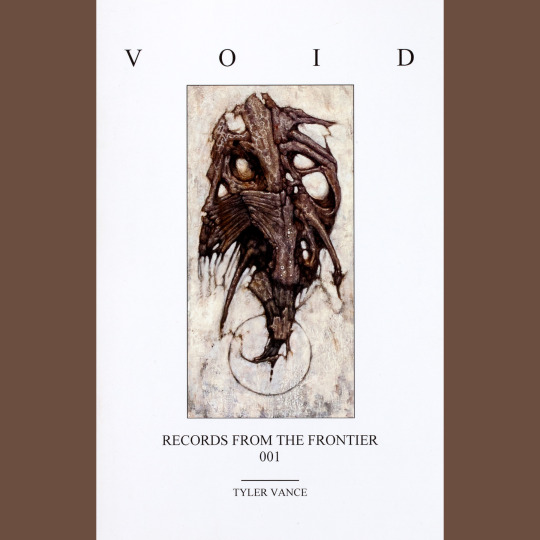
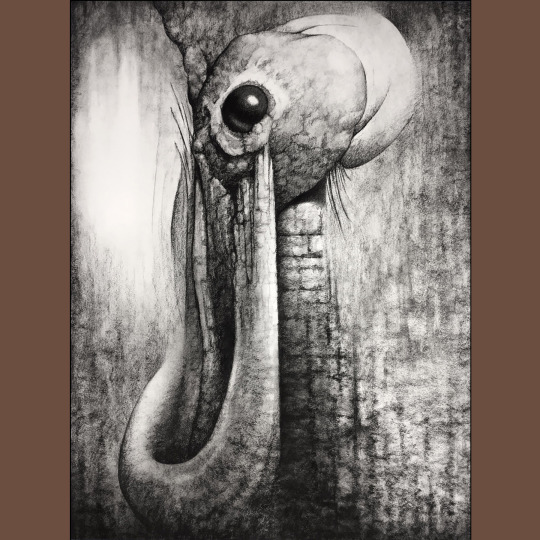
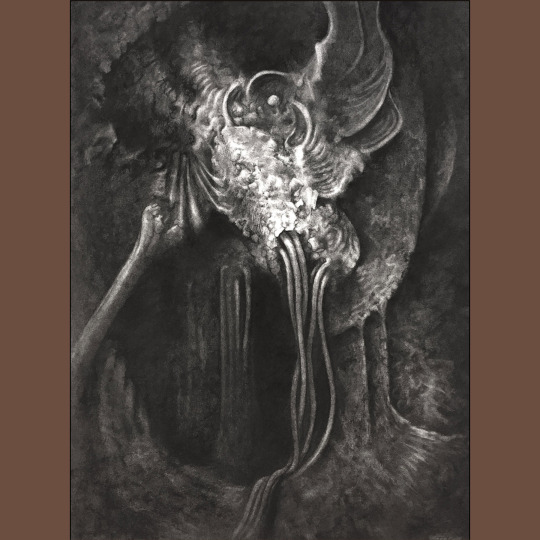
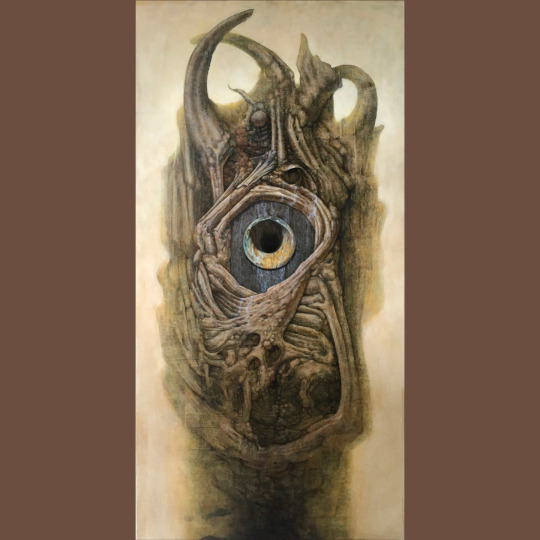

Another thing I feel like I say a lot: zine is a sort of meaningless term, interchangeable with chapbook and booklet and probably other words that all refer to the same basic format. I think for a lot of folks “zine” implies photocopied and chapbook means “really nice paper” and I am usually dismissive of these sorts of taxonomies. However! I have a bunch of publications (both real and, courtesy of the HP Lovecraft Historical Society, fake), dedicated to short monographs on different historical subjects or artifacts. These are formal looking, are printed on fancy paperstock and just feel, well, academic in their presentation. They’re still essentially zines, but also somewhat different. Tyler Vance’s Void (2021) feels of a kind with those.
Void: Records from the Frontier 001 is a world building exercise consisting of six of Vance’s gorgeously strange, fossil-like paintings accompanied by brief vignettes. Taken together, the reader/viewer should begin to cobble together some facts — there is a Void, people go in, sometimes they don’t come out, sometimes they come out carrying things with them. I don’t want to pollute your potential experience with my notions, so I will mostly leave it at that, but I find it and its sequel volumes wonderfully meditative and evocative. (OK, a little more: Stalker, Annihilation and Gibson’s short story “Hinterlands” are all touchstone for my reactions to Void).
I think it is well known that I like these sorts of no-system world-building projects (A Thousand Thousand Islands, Rainy City, Lodestar to Karamouska), but I like that this goes one step farther and, aside of the artist’s statement at the front, it feels like an in-universe artifact, a catalog for some strange museum exhibit, an auction book, a secret black market log. Volume two has similar vibes and oh man, volume three, A Young Person’s Introduction to Erratics, takes things in a fantastic new direction (that is pretty clearly signposted by the title). It will pull you even further into this strange underground.
Grab all three from his store. You won’t be sorry!
#roleplaying game#tabletop rpg#dungeons & dragons#rpg#d&d#ttrpg#Records From the Frontier#Void#noimport
145 notes
·
View notes
Note
I was thinking about tma and I have a thought about it but idk if maybe ppl would think it's kind of??? A cop out??? Idk but like my thought on this is like tma hinges on Smirkes 14 which- I strongly agree with you- is a patently stupid system of organizing the fears but tbh I feel like that stupidity strengthens tmas themes of cosmic horror and its critique of the philosophical ripples of 1. Enlightenment era ideas of empiricism and the resurgence of those sorts of attitudes in Victorian times (aka slotting all data into taxonomies regardless of their actual accuracy- for example in the real world Race Science comes to mind an inaccurate, arbitrary, stupid, harmful taxonomy developed out of whole cloth to harm and exploit the vulnerable. I consider smirkes 14 to be analogous to that sort of thing- the human impulse towards pattern seeking taken to the logical extreme of applying arbitrary and harmful taxonomies as though they have any internal accuracy when they just dont) 2. Entrenched English systems of power that assert themselves thru institutions- in this case aristocracy and academia (Jonah magnus, the magnus archives itself, the fairchildes, and the Lukas family explicitly. In terms of metaphor I consider those that serve the fears to sort of be metaphorically resonant w those irl who uphold unfair hierarchies such as monarchy or aristocracy. It even kind of plays out in the granular interpersonal workplace dynamics of the archive wherein martin - working class bg- had to fake his cv to get a job and is subsequently mistreated by his boss for not being competent or how Sasha was passed over for a promotion a she was clearly better suited for by a man who was not as qualified)
I don't think this is just a watsonian reading of something poorly written btw (tho tma definitely has its flaws and this interpretation still doesn't necessarily have to retroactively justify this writing choice.) I think it was intended to be understood this way since there are allusions in-text to the Christian parable of the blind men and the elephant and at another point someone (I think it was peter Lukas?) describes Robert smirkes 14 fears as analogous to an ants perception of a human hand descending upon it (paraphrasing here but like something like "would an ant perceive these massive separate appendages descending upon it as a single entity- fingers on a hand- or would the shear massiveness and incomprehensibility render each finger a unique tormentor, separate and independent, all torturing the ant.")
Sorry to be out of the blue but ur one of the few ppl I see critiquing the tma pantheon on the grounds that it's bad (which it is) and I was curious what u might think of what I had to say here
ok this is aggressive haterism so i'm not putting it in the tag and if you are super super super into the magnus archives this isn't meant as an attack or whatever this is just me doing criticism for fun.
so okay. i get wanting to view it this way because if you are trying to work with the text to come to an interpretation that is like. good. then this makes sense. so like this makes sense as an interpretation, but it doesn't really work for me because my critique is more doylist and also less willing to give the benefit of the doubt.
so part one is. in the end. i just think that the fourteen fears make the stories themselves worse. like i think that real human author jonathan sims is "writing to the fears" as in, he is writing horror stories to slot specifically into these little categories. which make his horror stories less interesting. both because he tends to invent cliches for himself and then double back to them and also for more reasons i will discuss later. so on a very basic "i want [MEDIA PRODUCT] to be good (as in fun and enjoyable to consume), and this is making it bad (as in kinda boring)" level, i think this isn't really a justification, you know? like you can say you made the thing bad on purpose but it's still bad. very occasionally a thing being bad on purpose as a self-reflexive critique makes it good, but not as often as just being good in the first place does.
and then part two is. i think you could argue that tma is a critique of the victorian urge to categorize and rationalize things but it's also just. an example of it. the fourteen fears make the individual stories hostile to analysis because they attempt to pre-chew and pre-analyze the stories, assigning them preexisting meanings so that they are already made-sense-of. this hampers them as horror (see part one) because for really good horror you need a sense of otherness a sense of uncanny and if you're like oh this one is the stranger and this one is the eye and etc. it lends a fundamental knowability that just. deflates them. but then also it means you can't analyze them and it's like.
okay. case study. so did you guys remember that tma has a mummy curse episode? i do. it's like flabbergasting to me that tma unironically has a mummy curse episode that's like. you know that's old school racist. are you serious? but like okay. analytically. the episode comes *pre-chewed*. because we know which power this is. this is terminus. this is death. so the underlying fear in this story is the fear of death. that's how we are *meant* to understand this tale. but like be serious. any idiot with half a brain can like, comprehend the underlying anxiety of The Mummy's Curse: it's a story about what if all the tomb raiding, the grave robbing, the mummy eating, in short all of the colonial violence done to things, which is only possible because of all the colonial violence done to people, came back to bite you. it's the anxiety of the colonizer, manifest guilt about what they have done to the colonized. and as much as jonny sims is essentially just copying his influences, those victorian stories he loves so much, that's still what it's about. hell, sims knows this: the reason the woman in the story is so unlikable, so greedy and grasping, so unsympathetic is that jonny sims is soothing his own anxiety: "well i want to write a mummy curse episode, but what if people think i, a white british man writing a mummy curse episode, am racist? what if they think i don't know colonialism is bad? better put a little 'colonialism is bad, mmmmmmmmkay?' opener in to make sure no one thinks i'm racist." but of course the other thing he does is he attempts to gut the story of that unpleasant little meaning. oh it's not the anxiety of the colonizer. it's not about the violence of the victorian era. it's just about death. well, phew, i'm glad i don't have to think about that.
and i'm using the mummy curse one as a case study but that's EVERYTHING. that's EVERYTHING. oh this story about being trapped in an infinite factory where you work isn't processing the horrors of work or of the violence inherent in every product under capitalism that you will never seen or of alienation or of bodies, this is just the fear of slaughterhouse animals. oh this clone of the most dangerous game isn't about colonialism or about dehumanizing people into animals it's just about the fears of literal animals. oh this fucking guy marrying a bug isn't processing any anxieties about sex or our bodies it's just fear of disease. like it flattens everything. the meaning of horror is super overdetermined, i'm not even saying that the mummy curse, which has a pretty obvious meaning as the anxiety of the colonizer, necessarily means only that! it's can certainly also be about death and about a thousand other things. stuff has multiple meanings. but the fourteen fears method rejects overdetermination, meaning bounces off these stories. and that makes them a lot more comfortable: you don't have to deal with the miserable, horrible, sick, reactionary underpinnings of horror stories, the way they (all horror stories, really) function to guard the boundaries of our sick society with slavering hateful jaws, if you just pretend they're about fear of heights or whatever.
like to be clear my argument here is that it's kind of impossible to make horror without reactionary elements so i'm not really criticizing jonny sims for Not doing that, and i'm also not arguing that jonny sims intentionally tried to build an anti-critique wall into his stories by inventing the fourteen fears, i'm just arguing that he kind of did and that makes the stories worse. and i think the way it rejects meaning is unconsciously self-protective from having to see the more unpleasant meaning of the work. and is therefore in itself kind of reactionary.
and i'm also criticizing him for writing a mummy curse episode because come on man, are you serious? but that's not as related to my larger point. though i do think his critique-proof wall shields him from noticing the implications.
part two point five: also i will not give him the benefit of the doubt and say that he was trying to kind of fix this issue with season five because season five was worse. guy who learned about progressive politics from twitter last year type understanding of systemic critique. guy who writes every character arc as a kind of Very Special Episode about Important Progressive Topic Of The Day but mostly only because he's scared of getting cancelled on twitter type critique. like horror is overdetermined. "My Horror Show Now Only Does #Issue Episodes Where I Make Systemic Critique For Babies" is a dumb way of reflecting on the way your overarching premise is kind of unintentionally an attempt to make your horror stories critique-proof. not that i necessarily think that was why season five was like that, i just think he got swept up in trying to make Progressive Media, but if it WAS it wouldn't be adequate.
part three: i think the "fingers of a hand" thing was a post-hoc justification because he sort of noticed his fears are a bit stupid. and i think, circle back to part one, that it doesn't solve the fundamentally doylist problem of the stories being written to the fears.
part four: on a very basic sort of ancient greek philosophy type level i just think the fourteen fears are not beautiful and true. quite frankly mister sims, if i was trying to divide all the world's fear into knowable categories, i would not make fucking fourteen of them! that's simultaneously too many and too few! and it's not even a nice number! i would not for some reason collapse together the fear of spiders and the fear of mind control! i would not split the fear of disease from the fear of the fact that we are all bodies with flesh! i would not make the fear of otherness mostly about clowns!
i would not different the hunt from the slaughter from the desolation you FUCKING BUFFOON.
^directed at jonny sims.
anyway thank you for the ask that was fun. i feel like i exorcised a demon out of my body.
14 notes
·
View notes